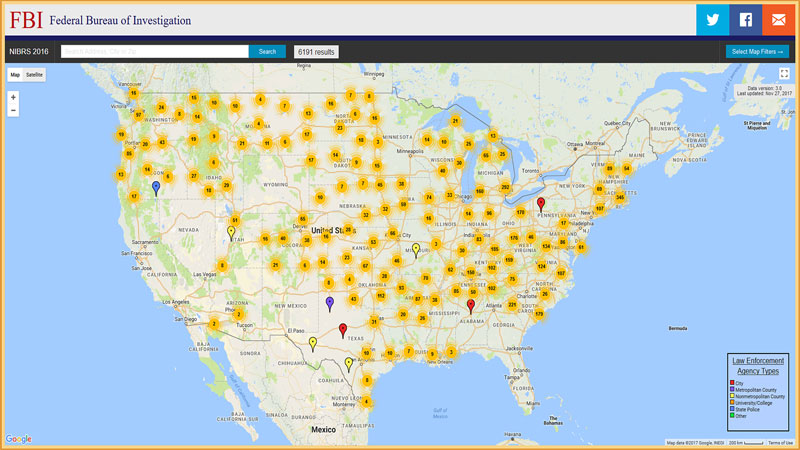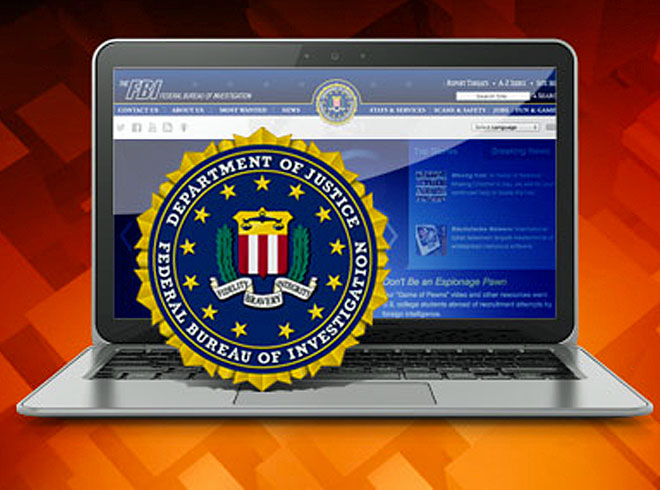
The FBI has released information on more than 6 million criminal offenses that were submitted to the Uniform Crime Reporting (UCR) Program’s National Incident-Based Reporting System (NIBRS) in 2016, and for the first time included data on animal cruelty.
Additionally, hacking and identity theft were added to the overall fraud offense category.
While NIBRS data is not yet nationally representative, 6,849 law enforcement agencies (about 37 percent of the country’s law enforcement agencies that participate in the UCR Program) contributed their data to the NIBRS, 2016 report, a 201-agency increase from 2015.
By 2021, NIBRS is scheduled to become the national standard for crime reporting, replacing the Summary Reporting System.
NIBRS provides additional information and context for criminal offenses, and when fully implemented, it will assist law enforcement in using their resources efficiently and effectively.
(Learn More. The transition to the National Incident-Based Reporting System (NIBRS) will improve the accuracy and timeliness of our nation’s crime statistics, help identify crime patterns and trends, and aid in crime prevention. Courtesy of the FBI and YouTube. Posted on Dec 21, 2018.)
“Information that is accurate, accessible, and complete enhances and informs conversations about policing,” FBI Director Christopher Wray said in his message in the report.

“It helps us learn how and why crimes occur and what we can do to prevent them from happening in the first place.”
“It helps law enforcement to be more proactive, helps communities use resources more strategically, and it improves the safety of our nation’s citizens and law enforcement officers.”
In the new categories, there were 1,126 animal cruelty cases reported to NIBRS.
In recent years, law enforcement and other groups have advocated for adding animal cruelty to FBI crime statistics as a way to better understand it as a crime against society and also because animal cruelty is sometimes linked to domestic violence and other violent crimes.
Of the more than 250,000 fraud offenses reported by law enforcement to NIBRS in 2016, 22,894 were identity theft offenses and 581 were hacking/computer invasion offenses.

Some additional highlights from NIBRS, 2016:
- Based on aggregate data, NIBRS agencies reported 5,237,106 incidents involving 6,101,034 offenses with 6,437,018 victims.
- There were 4,963,644 offenses with known offenders (in which at least one characteristic of the offender was known.) Of those offenders whose age was known, 43.5 percent were between the ages of 16 and 30. Sixty-three percent of known offenders were men, and 25.6 percent were women. In other cases, sex of the offender was unknown.
- Of the reported offenses, 62.5 percent were crimes against property, 22.7 were crimes against persons, and 14.8 percent were crimes against society (such as gambling or animal cruelty).
- More than half of the victims (52.4 percent) knew their offenders (or at least one of the offenders if the incident included more than one offender). Additionally, 24.3 percent of the victims were related to their offender (or at least one offender if more than one was present.)
- The NIBRS report contains data on 3,261,521 arrestees. Of those who were arrested, 34.1 percent were 21 to 30 years old. More than 71 percent of arrestees were men, and 28.3 percent were women.
More NIBRS data can be found in the NIBRS interactive map or in the Crime Data Explorer tool. To find out more about the benefits of NIBRS participation, see at bottom.
FBI Launches Crime Data Explorer Tool
The FBI recently released its Crime Data Explorer (CDE), an interactive tool that enables law enforcement and the public to more easily use and understand the massive amount of published UCR data.

CDE users can easily search, sort, and compare crime statistics; create charts and graphs; download tailored reports; and use application programming interface (API) to build their own web applications.
For mobile users, CDE offers a streamlined, mobile-responsive web design that works on cell phones and tablets as well as computers.
CDE currently includes on data on hate crime, assaults on law enforcement, police employees, agency participation, cargo theft, and human trafficking.
Additional datasets and tools will continue to be added to the tool.
Benefits of NIBRS Participation
When used to its full potential, the UCR Program’s National Incident Based Reporting System (NIBRS) identifies, with precision, when and where crime takes place, what form it takes, and the characteristics of its victims and perpetrators.
Armed with such information, law enforcement can better define the resources it needs to fight crime, as well as use those resources in the most efficient and effective manner.
Although most of the general concepts for collecting, scoring, and reporting UCR data in the Summary Reporting System (SRS) apply in NIBRS, such as jurisdictional rules, there are some important differences in the two systems.
The most notable differences that give NIBRS an advantage over the SRS are:
-
No Hierarchy Rule
- In the SRS, the Hierarchy Rule requires law enforcement agencies (LEAs) to report only the most serious offense per incident (with the exceptions of arson and human trafficking); therefore, they do not report lower-listed offenses in multipleoffense incidents.
- In NIBRS, LEAs report every offense occurring during an incident provided the offenses are separate and distinct crimes, not just as part of another offense, i.e., a “mutually exclusive” crime.
- (For more information about mutually exclusive offenses, refer to the NIBRS Technical Specification, Data Element 24, Victim Connected to UCR Offense Code, at https://ucr.fbi.gov/technical-specifications.)
-
Revised, Expanded, and New Offense Definitions
- The FBI UCR Program revised several offense definitions in SRS for NIBRS (e.g., the definition of assault to include the offense of intimidation, the definition of burglary to include self-storage units with regard to the Hotel Rule [i.e., since all units are under a single manager, the burglary will count as one offense, but up to 99 individual units can be reported].
- Furthermore, NIBRS defines and collects specific sex offenses, including such crimes as rape, sodomy, and sexual assault with an object (which together meet the revised, broader UCR definition of rape), and fondling; and sex offenses, nonforcible, including such crimes as statutory rape and incest.
-
Greater Specificity in Reporting Offenses
- Using NIBRS, law enforcement can report offense for 24 Group A offense categories (including 52 specific crimes) as opposed to the 10 Part I offenses in the SRS.
- In addition, NIBRS captures arrest data for the Group A offenses and 10 Group B offense categories (including 10 crimes), while the SRS collects arrest data for 20 Part II crimes.
- Also, because the SRS collects most of its crime data in the form of categories (e.g., age groupings and property value groupings), it provides very little capability to break down the resulting data into specific subcategories.
- However, because NIBRS collects the details of crime incidents, it allows much greater NIBRS, 2016 U.S. Department of Justice—Federal Bureau of Investigation Released Fall 2017 2 Uniform Crime Reporting Program National Incident-Based Reporting System specificity in reporting.
- Some of those details include type of victim, residential status of victim and arrestee, weapons data for several crimes, and the value of property stolen or recovered.
-
Distinction between Attempted and Completed Group A Crimes
- Except for the offenses of rape and burglary, the SRS does not differentiate between attempted and completed Part I crimes.
- NIBRS recognizes the difference between attempted and completed crimes for all Group A offenses.
-
Additional Scoring Category
- In addition to the categories of Crimes Against Persons (e.g., murder and nonnegligent manslaughter, rape, and aggravated assault) and Crimes Against Property (e.g., robbery, burglary, and larceny/theft), NIBRS offers the category of Crimes Against Society.
- These crimes are not against persons because they do not actually involve an injured party; nor are they against property because property is not the object of the crime.
- Program developers created the category to represent society’s prohibitions of engaging in certain types of activity, such as drug/narcotic offenses, gambling offenses, pornography/obscene material, and prostitution offenses.
-
Expanded Victim-to-Offender Relationship Data
- In the SRS, law enforcement reports the relationship of the victim to the offender (e.g., the victim was the husband, wife, employer, or employee, of the offender) only for homicides (i.e., murder and nonnegligent manslaughter, manslaughter by negligence, and justifiable homicide).
- In NIBRS, however, law enforcement reports a victim’s relationship to the offender(s) when the individual was the victim of a Crime Against Person, such as an assault offense, homicide offense, kidnapping/abduction, or sex offense.
- LEAs also report victim-to-offender relationship data for robbery (Crimes Against Property) because one of its elements is an assault, which makes it a violent crime.
- (NIBRS also collects other types of victims, i.e., law enforcement officer, business, financial institution, government, religious organization, and society/public.)
-
Expanded Circumstance Reporting
- The SRS and NIBRS both provide for collecting circumstance data for homicides, but NIBRS also allows law enforcement to report circumstance data for aggravated assault.
- Furthermore, NIBRS permits the entry of up to two circumstance codes for each murder or aggravated assault.
-
Expanded Collection of Drug-Related Offenses
- In the SRS, the subcategories of drug violations are limited to sale/manufacturing and possession.
- However, in NIBRS, LEAs can report the unlawful cultivation, manufacture, distribution, sale, purchase, use, possession, transportation, or importation of any controlled drug or narcotic.
- Agencies can also report the suspected drug type in one of the expanded drug-type categories.
- In NIBRS, 2016 U.S. Department of Justice—Federal Bureau of Investigation Released Fall 2017 3 Uniform Crime Reporting Program National Incident-Based Reporting System the event of a drug seizure, agencies can report the estimated quantity.
- NIBRS also allows agencies to report the unlawful manufacture, sale, purchase, possession, or transportation of drug equipment (paraphernalia). •
-
Use of Drugs
- In addition to capturing actual drug offenses, LEAs using NIBRS can report whether they suspect offenders of various other offenses of having used drugs or narcotics during or shortly before the commission of the crime(s).
-
Capturing Computer Crime
- To combat the growing problem of computer crime, (i.e., crimes directed at and perpetrated through the use of computers and related equipment) NIBRS provides the capability to indicate whether a computer was the object of the reported crime and to indicate whether the offenders used computer equipment to perpetrate a crime.
-
Association of Update Reports
- LEAs handle information updates, such as unfounding an offense with subsequent submissions via the SRS, but there is no way to tie the update to the original offense.
- In NIBRS, however, updated information is available with, and directly tied to, the original incident.
-
Identification of Common Problems or Trends
- Aside from national data requirements, many individual LEAs have very sophisticated records systems capable of producing a full range of statistics in their own jurisdictions.
- Some local and state incident-based reporting systems include additional data elements and data values to satisfy their local and state needs.
- As a byproduct of all of those systems, NIBRS provides more common links among agencies.
- As more LEAs use NIBRS, it will allow the identification of common crime problems or trends among similar jurisdictions.
- Agencies can then work together to develop possible solutions or proactive strategies for addressing the issues.
-
More Useful Data
- Once the majority of LEAs that participate in the UCR Program submit their data via NIBRS, legislators, municipal planners and administrators, academicians, penologists, sociologists, and the general public will be better able to assess the nation’s crime problem.
- Law enforcement is a public service and as such requires a full accounting from the police commissioner, chief, sheriff, or director as to the administration of the agency and the status of public safety within the jurisdiction.
- By participating in the NIBRS, agencies will have statistics to fulfill this responsibility.
- The NIBRS furnishes information on nearly every major criminal justice issue facing law enforcement today.
- The FBI’s UCR Program collects NIBRS data from all levels of law enforcement (i.e., city, university/college, county, state, tribal, and federal) and aggregates the data at the level and in the manner best meeting the informational needs of the data user.
- NIBRS, 2016 U.S. Department of Justice—Federal Bureau of Investigation Released Fall 2017 4 Uniform Crime Reporting Program National Incident-Based Reporting System
For More Information LEAs that want more information about making the transition to NIBRS should e-mail the FBI at UCR-NIBRS@fbi.gov.
LEAs should direct questions about specific facets of the UCR Program to the appropriate area.
A listing of UCR Program contacts is available at https://ucr.fbi.gov/ucrprogram-contacts.
For questions about the NIBRS publication, please direct your e-mail to crimestatsinfo@fbi.gov.
More NIBRS data can be found in the NIBRS interactive map or in the Crime Data Explorer tool.























